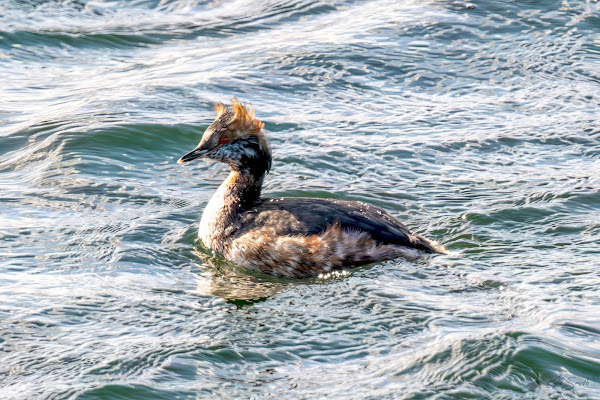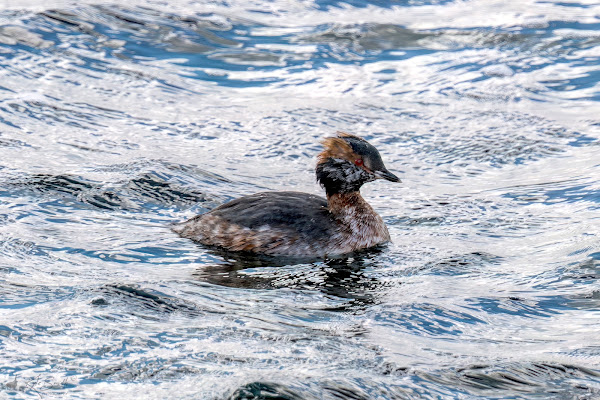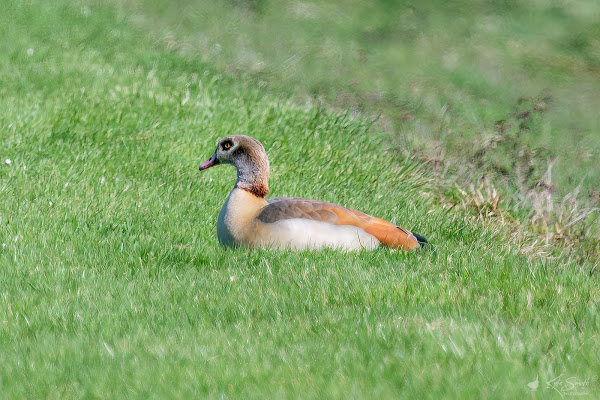The weekend arrived, so Kev and I discussed where we might go birding, thinking about where we might enjoy a range of species. Staines Reservoir looked good as there were reports of both Slavonian and black-necked grebes, water pipit a few days earlier (still in the area?), and a garganey at Staines Moor next door. We also often have ring-necked parakeets over there. Sold.
Staines Reservoir comprises two reservoirs, referred to as the North and South Reservoirs, providing a water supply for domestic and industrial use in the surrounding areas. The North Reservoir completed in 1902 and the South Reservoir completed in 1909 and were created by damming the River Colne and flooding the surrounding area; the combined area of both reservoirs is approximately 280 acres (113 hectares). The reservoirs and their surrounding areas provide habitat for a variety of bird species and are designated as Sites of Special Scientific Interest (SSSI) due to their ecological importance. Staines Reservoir has also recorded sightings of an array of rare and migrant bird species, with various grebe and diver species often reported out of the breeding season.
We arrived and stopped for our usual breakfast, waiting in the car park for a short while hoping for a flyover from parakeets, but we had none. We jumped into the car, made our way to access the reservoir from the causeway that splits the North and South bodies and noticed how cold it was in the wind, making us resort to wearing gloves. We saw tufted ducks, goldeneye, coot and gulls and gradually made our way along the causeway. Meadow pipits rose and flew along the sloped concrete down to the water's edge. One bird looked interesting as it stayed very close the water’s edge, but we could never get a good look at it.
About halfway across the causeway we spotted a grebe and as we got close, we could see it was a Slavonian grebe in spring transitional plumage. I've only ever seen this species in winter plumage previously - perhaps one day I'll see them in their full glory. They feed mainly on fish and arthropods but are able to adapt according to food availability. They are very agile underwater, and forage by diving from the surface for around 20-30 seconds, but they also take food from the surface catching flying insects and floating items.
As we watched and I took photographs, a second bird appeared to the left - a a black-necked grebe, and a striking waterbird species ... result. During the breeding season, they display a blackish-brown neck and head, contrasting sharply with their white cheeks and throat. They have a black cap extending down to the eye, and their back is dark brown. Outside the breeding season, their plumage becomes more subdued, with less contrast between the black and white areas. We were in luck and our bird was looking very dapper. They are migratory birds, breeding in the UK during the summer months and migrating to warmer regions in southern Europe and northern Africa during the winter.
The feeding habits of black-necked grebes is the same as that for Slavonian grebes and so it was no surprise to see them working along together, getting closer and closer; eventually close enough to get them in the same frame.
At the end of the causeway we could see shoveler ducks, shelducks and a single Egyptian goose. We regularly scanned the black-headed gulls hoping for a little gull but no such luck. We chatted with a few other birders and decided that we'd head over to Staines Moor where a garganey had been reported the night before and at first light; there were also reports of ring-necked parakeets over.
We located where to park and set out along the path, passing birders coming the other way. Unfortunately, it seemed the garganey hadn't been seen since first light and these people had decided they'd given it enough time; they also mentioned seeing parakeets and blackcaps along the track. Although we could hear blackcaps, we couldn’t get one out in the open. We heard and then saw a ring-necked parakeet in a tree, but so briefly that I didn't get a photo.
We reached the advertised "five-bar gate" and found a birder scoping just beyond - he'd been here a couple of hours and not had a sniff. He eventually drifted off and a couple of ring-necked flew over. We continually scanned and scoped the water, working both from the gate and from under the trees, swapping positions and occasionally meeting up. I drifted back to the gate and eventually Kev joined me, setting up his scope - with no action in front, and not wanting to leave the other area unwatched, I strolled back. Up went a call and Kev had spotted the garganey - I rushed over and caught it as it swam left and out of view. It was over a stretch of water, through some reeds and in the water on the other side - distant and largely obscured.
Garganey breed in the UK during the summer months, typically between April and July. They prefer shallow wetlands with dense vegetation for nesting, such as marshes, reedbeds, and flooded grasslands such as the habitat in front of us. They are considered a Schedule 1 species under the Wildlife and Countryside Act 1981, providing them with legal protection against disturbance and destruction of their nests. While they are not considered globally threatened, conservation efforts are in place to protect their breeding and wintering habitats.
We waited and hoped - occasionally some gadwall came around the edge of the reeds but were chased back by a coot - some teal worked past further back. A few other couples appeared, and I spotted the garganey briefly at the far right but it was flushed back out of view - I was the only person to have seen it. Another quarter of an hour past and Kev and I saw the bird over and between the reeds. It broke left and followed some teal across and out of view - I managed a photo and Kev a video.
We left space for others to get a view from where we'd been and soon made our way back along the track, now trying to locate a blackcap. We had a couple of jays in the trees but never had any eyes on them but saw a couple of birds fly across and up into a distant bush. I managed to pick out one of the birds working through a bush and could see it was a female blackcap - never did get my eyes on the male (probably the other bird). My first of the year.
Rain started to fall and some of the birders we'd left behind caught up with us as we reached the car. We decided that we'd detour to Ivinghoe Beacon and see if we could spot any of the wheatear reported the day before.
I'd never been before - Ivinghoe Beacon is a prominent chalk hill located in the Chiltern Hills, a designated Area of Outstanding Natural Beauty in Buckinghamshire. Rising to a height of 233m (764ft) above sea level, it offers commanding views of the surrounding countryside, making it a popular destination for hikers, walkers, and nature enthusiasts. Kev had visited and seen ring ouzel in the past.
There were quite a few hikers, dog-walkers, and families and so we decided to make some long-range searches with the scope, spotting up to four black rabbits - Kev was enthused with these. He then smashed it picking out a wheatear in a very distant field. Later one became two, then two became four and four became seven.
We added mainly raptors (kestrel, buzzard and red kite) and a very distant stonechat. With no further plans we made for home, and I'd added six new species for the year.
Year list: 159












No comments:
Post a Comment